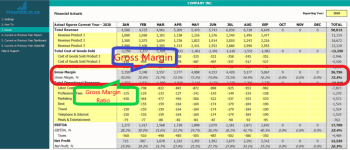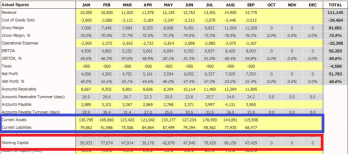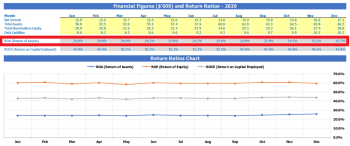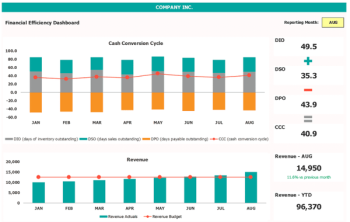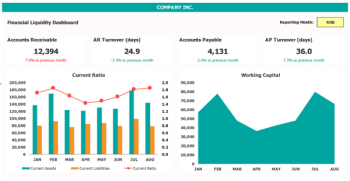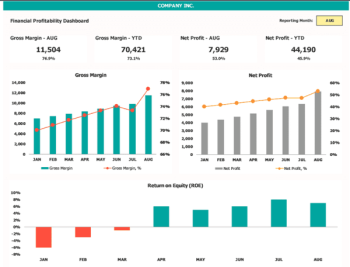Related Blogs
- Private equity investors: what to know
- Valuing a Family Business: Everything You Need to Know
- A Complete Guide to Financial Modeling
- How to successfully manage cost management and accounting in your business
- Unlock the power of financial modeling for your business
Financial performance indicators are of particular importance in the financial sector, as every company must regularly inspect and analyze performance to maintain a healthy status and avoid any future bottlenecks. The group that deals with these performance checks is expected to effectively report to management on the effectiveness of the business and any shortcomings. For these, financial advisors need an in-depth knowledge of financial metrics to measure business performance. By using these key financial indicators through the power of Financial Business Intelligence, you can make your financial data more informative and easier to manage.
Download the Excel template ⟶
Download the Excel template ⟶
What are financial indicators?
Key Financial performance indicators or measures are the measurable values that reflect the financial condition and performance of the business and provide quick insights into sales, expenses, and cash flow. These Key Financial Indicators are used to optimize and modify business financial strategies to achieve the company’s objective and objectives.
KPIs are for financial experts only?
No! It’s just a myth that you need to have a financial degree to understand the meaning of a company’s key financial indicators. You don’t have to be a financial advisor or a chartered accountant to understand the key benefits KPIs can bring to your business. However, as a business owner, you should have a cursory knowledge of balance sheets, cash statements, and other financial reports to best utilize the best financial KPIs to improve your business.
Key Financial Performance Indicators (KPIs) are the tools that help you measure and track critical areas of your business performance. It provides you with a general picture of your business in numbers. These KPIs allow you to make necessary changes in areas of underperformance and prevent any potential loss. Additionally, quantifying key financial performance measures the effectiveness of your efforts and ensures long-term sustainability in your business model.
How to use KPIs for improvements?
Your system’s key financial performance indicators help you identify and understand the overall impact of the various financial entities affecting your business. Plus, these invaluable financial KPIs give you insight to correct issues with policies, strategies, and products that impact one or more KPIs.
The three main key financial performance indicators
If you start digging for business metrics to measure, you will find many sources of information, but not all of them are relevant. So, to fully understand your business performance metrics and what can help grow the business and fiscal health, let’s figure out what useful metrics should be measured by a business founder. Here are the top three financial metrics or key performance indicators that every business should be watching closely.
Gross margin
Profit calculation is the simple process of knowing the amount gain after selling any product. But it does not say whether the business is overall in profit or not, and additional information is needed to assess the performance of the business. Therefore, profit margins are calculated to properly assess the performance of the business. Profit margin is the amount of profit as a percentage of sales revenue.
The gross profit margin KPI is the percentage of sales revenue after deducting the cost of sales. Thus, it reflects the amount of profit for every dollar of sales revenue received. You can calculate KPI gross profit margin with this simple formula below.
For example, a gross profit margin of 40% means that every dollar of sales provides 40 cents of gross profit. This calculation provides you with a number that your business adds when you sell, but it does not guarantee an efficient business.
For example, if last year your business had a gross profit of ,000 with revenue of 0,000, and this year it had a gross profit of 0,000 with revenue of business of 0,000. Apparently, it looks like your earned business doubled the gross profit than last year, but actually your sales revenue tripled this year, but your gross profit didn’t.
Therefore, it indicates that you should take some steps to match the ratio of your gross profit and sales revenue to last year. Here you need the gross profit margin, which provides you with the ratio of gross profit to sales revenue for the specified period. Below is an example of gross profit and gross profit margin.
It helps to compare your company’s gross profit, yearly or even monthly to quickly highlight the problem. As you can see in the example above, gross profit declined despite sales revenue tripling. Once you find it, you better decide whether to negotiate with suppliers for a reduction in raw materials or reduce your expenses to match your gross profit with the increase in sales revenue.
Working capital
Without working capital, the list of top 3 key financial indicators cannot be complete. Unlike other KPIs, it is not a ratio or proportion; Instead, it’s the number of dollars you have left with you after deducting current liabilities from current assets.
Current assets include cash on hand, inventory, account receivables and all prepaid expenses. While current liabilities represent all obligations and debt repayments that are due within 12 months. It includes accounts of accounts, debt repayments, accrued expenses, taxes payable, salaries and wages.
This key financial indicator illustrates the operational efficiency of the company and the short-term financial health, which helps you in financial reporting and analysis. It is similar to solvency as it deals with assets and liabilities to represent the strength of your balance sheet. The only difference between solvency and working capital is instead of creating a ratio; This is the difference of the two finances.
You can calculate working capital by simply deducting your liabilities from your assets as shown below.
It is very similar to the calculation of cash inflows and outflows, which drives your day-to-day operations. Positive working capital shows the strength of your business and the ability to grow. Whereas a negative working capital reflects a deficit to operate your business for a specified period. And in this case, you have to rely on the debt to last you until the next sales. Below is an example of current assets, current liabilities and working capital.
This vital key financial indicator informs you of the state of your business through available operating funds. It reflects the strength of the amount you can cover your short-term financial liabilities. You need to keep an eye on this financial performance metric and keep it positive by collecting receivables from your customers sooner rather than later.
Keep in mind that high working capital does not mean that the company is very efficient and has more capital to pay liabilities. Yet, it can also mean that the company is not investing excess cash on business development.
Return on Assets (ROA)
Return on Assets (ROA) is another vital financial performance indicator that shows the profitability of the company regarding its assets. It is a ratio of net income to total assets, while assets include both debt and equity. Growing ROA is a healthy indicator. It indicates that the business generates more profit with the same assets or requires fewer assets to generate the same profit.
Download Ratios Ratios Excel Template Calculator in Excel
This measure of financial performance is vital for potential investors because it provides solid numbers on how effectively management is using their assets to generate profits or how well management is converting assets into net profit. The higher the performance, the more effective and efficient management uses resources. Below is the formula to calculate return on assets.
Here the net profit is the net profit for the year, and the average asset is equal to the starting asset minus the ending asset divided by 2. Below is an example of how the return on assets is calculated in a well-designed financial model .
The ROA KPI is a vital ratio used to analyze the profitability of any business. This ratio is generally useful when comparing profitability between periods or when comparing two different companies with the same size in the same industry. ROA also represents a company’s scale and performance while comparing two different companies.
Download Ratios Ratios Excel Template Calculator in Excel
Not to mention that different industries have different ROAs. For example, capital-intensive industries that require a high value of fixed assets for their operations generally have a lower ROA. Their significant asset base increases the denominator of the formula and results in a lower value. So naturally, high ROA means high income with a low asset base.
For your convenience, FinModelslab has developed Financial KPI Dashboard , which helps you calculate all the key financial indicators of a company by entering the required data. Below is a brief introduction to this financial dashboard.
KPI Financial Dashboard
Download the Excel template ⟶
Enter the company’s KPI goals and monthly financial results, and the financial dashboard will take care of creating the beautiful management dashboard with handy charts and metrics!
The Financial Dashboard Excel spreadsheet will produce 3 kPI dashboards that can be viewed month by month with comparisons and growth trends.
Download the Excel template ⟶
Financial Efficiency Dashboard
Most of the requested financial performance metrics measure the efficiency of your business, such as revenue, cash conversion cycle, and budget vs. revenue statement analysis.
Download the Excel template ⟶
Liquidity Metrics Dashboard
It reflects key financial performance indicators to track cash like accounts receivable and current revenue and payable ratio.
Profitability Metrics Dashboard
The basic indicators to measure are gross margin and net profit. There is no doubt that the first thing you want to start a new business – is its’ efficiency and profitability.
Download the Excel template ⟶
To achieve his maximum, the business owner does various steps to improve the performance of his business. But, of course, to see if these steps affect you, you need to keep track of key financial indicators.
List of financial KPI metrics available in the financial dashboard
- Gross margin
- Working capital
- return on assets
- Income
- Cost of Goods Sold
- EBITDA
- Operational expenses
- net profit
- Quick report
- Current Ratio
- Return on Equity (ROE)
- Accounts Receivable
- Account payable
- Conversion cash cycle
Benefits of the KPI Dashboard
- Analyze actual revenue and compare it with budget
- Real-time gross profit information
- See working capital dynamics over the year
- Compare your assets and liabilities
- Quick decision-making KPIs following month-to-month month-to-date and year-to-date
- Monitoring changes in margin and net profit
- Keep an eye on the return of assets (ROA)
- Determine return on equity (ROE)
- Analyze your company’s liquidity
FinModelslab has developed a KPI model, Excel, which visually demonstrates KPI effectiveness, profitability and liquidity changes. You won’t need advanced Excel skills or a degree in finance – download a financial dashboard, enter your data and enjoy your interactive financial dashboard.
Some of the well-designed and best-selling Excel KPI templates are listed below:
- Annual Financial Performance Dashboard
- Valuation Ratios Excel Template Calculator
- Debt Ratios Excel Template Calculator
- Operating Performance Ratios Excel Template Calculator
- Profitability Ratios Excel Template Calculator
- Return Ratios Excel Template Calculator
- Liquidity Ratios Excel Template Calculator



